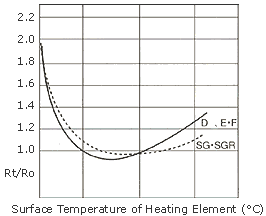

| Characteristics Items | Unit | Type D | Type E&F | Type SG&SGR |
|---|---|---|---|---|
| Pretension Density | 3.2 | 3.2 | 3.1 | |
| Bulk Density | 2.5 | 2.5 | 2.8 | |
| Apparent Porosity | % | 23 | 23 | 5 |
| Bending Strength | MPa at 25°C | 49 | 49 | 98 |
| Specific Heat | kJ/kg+°C at 25°C~1300°C | 1.0 | 1.0 | 1.0 |
| Heat Conductivity (Hot Zone) |
W/m +°C at 1000°C | 14~19 | 14~19 | 16~21 |
| Nominal Resistance (Hot Zone) |
Ω cm at 1000°C | 0.10 | 0.08 0.10 |
0.016 |
| Coefficient of Thermal Expansion | 1000°C(X10-6/°C) | 4.5 | 4.5 | 4.5 |


As shown in Fig.1, the temperature coefficient of "EREMA" resistance-temperature characteristic is negative up to 650 to 700(When temperature goes up the resistance value goes down.)Then, over that temperature, it turns to positive (When temperature goes up, a resistance value goes up.).
Note: The EREMA resistance is usually measured at 1000 in open-air. The stated nominal resistance has no relationship to that at room temperature. (ref. Fig.1)
Fig 1) Typical Resistance Temperature Characteristic of EREMA Heating Element at a Standard Calibration of 1000°C

The EREMA heating element is made of chemically stable, recrystalized silicon carbide, and is superior to metal heating elements in terms of high temperature stability, oxidation resistance and corrosion resistance. When heating elements are operated at high temperatures, they come in contact and react with gas atmosphere (vapor, hydrogen, nitrogen, sulfur, halogen, etc.), molten alkali, alkaline salts (K2CO3, KCL, KOH, NaF, etc.), molten metals (Fe, Ni, Co, etc.), and some metal oxides (CuO, Pb3O4, FeO, etc.). Extra precaution is necessary during operation for elements are subjected to corrosion or oxidation when the above reactions occur.
When EREMA heating elements are used in gas atmospheres, refer to "Effects of Atmosphere Condition on EREMA Heating Elements."
When designing a furnace, and the above corrosive substances are involved, caution must be exercised to avoid any direct contact between the EREMA heating element and the harmful atmosphere.








